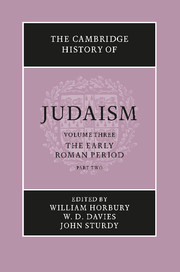Book contents
- Frontmatter
- 1 The archaeology of Palestine 63 bce–ce 70
- 2 The Herodian Temple
- 3 Recent archaeology in Palestine: achievements and future goals
- 4 The contribution of Jewish inscriptions to the study of Judaism
- 5 The social, economic and political history of Palestine 63 bce–ce 70
- 6 The Diaspora in the Roman period before ce 70
- 7 The Gentiles in Judaism 125 bce–ce 66
- 8 Gentiles as seen by Jews after ce 70
- 9 The synagogue
- 10 The Temple and the synagogue
- 11 The early liturgy of the synagogue
- 12 Women in the synagogue
- 13 The Pharisees
- 14 The Sadducees – their history and doctrines
- 15 The Essenes
- 16 The baptist sects
- 17 The troublemakers
- 18 The Samaritans and their sects
- 19 Galilean Judaism and Judaean Judaism
- 20 Jesus: from the Jewish point of view
- 21 Paul: from the Jewish point of view
- 22 Jewish Christianity
- 23 Apocalyptic: the disclosure of heavenly knowledge
- 24 The Qumran sectarian writings
- 25 The Dead Sea Scrolls and pre-Tannaitic Judaism
- 26 Prayer in the Qumran Texts
- 27 Philo of Alexandria
- 28 Josephus (ce 37–c. 100)
- 29 The rabbi in second-century Jewish society
- 30 The Hellenistic–Roman Diaspora ce 70–ce 235: the archaeological evidence
- 31 The legacy of Egypt in Judaism
- 32 Jewish elements in gnosticism and magic c.ce 70–c.ce 270
- Bibliographies
- Index
- References
11 - The early liturgy of the synagogue
Published online by Cambridge University Press: 28 March 2008
- Frontmatter
- 1 The archaeology of Palestine 63 bce–ce 70
- 2 The Herodian Temple
- 3 Recent archaeology in Palestine: achievements and future goals
- 4 The contribution of Jewish inscriptions to the study of Judaism
- 5 The social, economic and political history of Palestine 63 bce–ce 70
- 6 The Diaspora in the Roman period before ce 70
- 7 The Gentiles in Judaism 125 bce–ce 66
- 8 Gentiles as seen by Jews after ce 70
- 9 The synagogue
- 10 The Temple and the synagogue
- 11 The early liturgy of the synagogue
- 12 Women in the synagogue
- 13 The Pharisees
- 14 The Sadducees – their history and doctrines
- 15 The Essenes
- 16 The baptist sects
- 17 The troublemakers
- 18 The Samaritans and their sects
- 19 Galilean Judaism and Judaean Judaism
- 20 Jesus: from the Jewish point of view
- 21 Paul: from the Jewish point of view
- 22 Jewish Christianity
- 23 Apocalyptic: the disclosure of heavenly knowledge
- 24 The Qumran sectarian writings
- 25 The Dead Sea Scrolls and pre-Tannaitic Judaism
- 26 Prayer in the Qumran Texts
- 27 Philo of Alexandria
- 28 Josephus (ce 37–c. 100)
- 29 The rabbi in second-century Jewish society
- 30 The Hellenistic–Roman Diaspora ce 70–ce 235: the archaeological evidence
- 31 The legacy of Egypt in Judaism
- 32 Jewish elements in gnosticism and magic c.ce 70–c.ce 270
- Bibliographies
- Index
- References
Summary
The nature of Jewish liturgical expression in the period immediately preceding the destruction of the Second Temple and the loss of any semblance of Jewish political independence in 70 ce is clearly of interest to a wide body of scholarship. Historians of Jewish religious practice, analysts of Christian origins and students of the cultic forms in existence in the Hellenistic and Roman worlds all have sound reasons for seeking to reconstruct for themselves what may for the moment, pending the more accurate assessment and definition that I hope to offer, be referred to as ‘the early liturgy of the synagogue’.
In pursuit of this reconstruction, liturgists have sometimes turned for guidance to the authoritative Jewish prayer-books of almost a thousand years later, or even of the more modern period, and sought to extrapolate backwards, making assumptions that defy the vast chasms of history, geography and ideology that separate one millennium from another. Those who have adopted such a position have transplanted some or all of the rabbinic rites and customs of tenth-century Babylon or early mediaeval Europe to first-century Judaea and the surrounding Jewish Diaspora and declined to distinguish the continuity of some liturgical traditions from the patent novelty of others. However methodologically untenable the theory underlying such an approach, the picture painted of proto-rabbinism and its liturgical practice was a clear one, unobfuscated by doubts and complications.
Recent, more reliable research in the field tends, on the other hand, to stress the lack of concrete evidence, the questionable admissibility of sources even one or two centuries after the destruction of the temple, and the complex nature of Judaism in the time of Jesus and Hillel, thus shying away from a commitment to simple description and taking refuge in a welter of doubt and hesitancy.
- Type
- Chapter
- Information
- The Cambridge History of Judaism , pp. 326 - 357Publisher: Cambridge University PressPrint publication year: 1999
References
- 2
- Cited by



